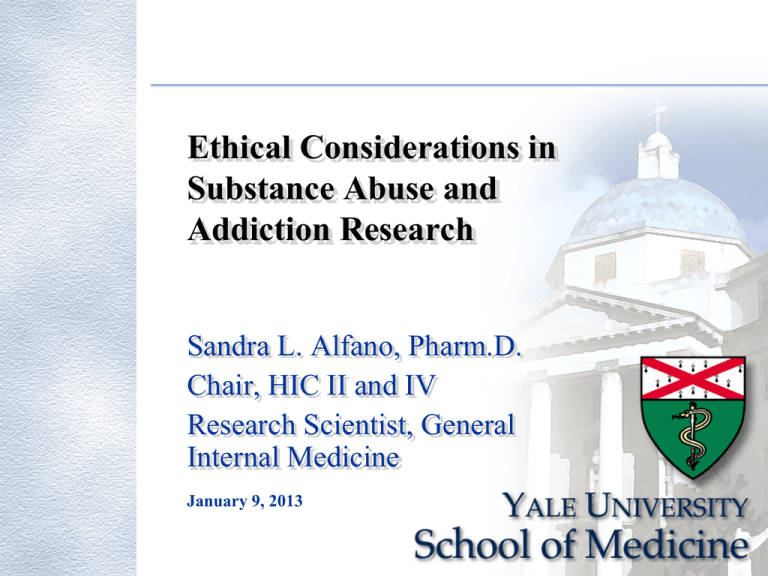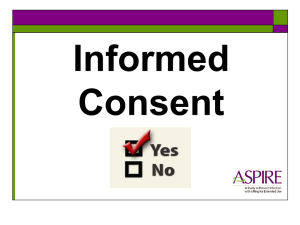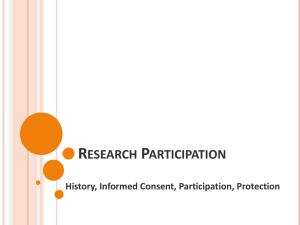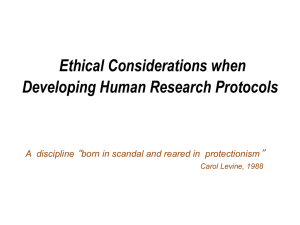Ethical Considerations in Substance Abuse and Addiction Research
advertisement

Ethical Considerations in
Substance Abuse and
Addiction Research
Sandra L. Alfano, Pharm.D.
Chair, HIC II and IV
Research Scientist, General
Internal Medicine
January 9, 2013
Objectives
• Understand the ethical foundations of
human subjects research
• Explore the conflicts and tension
between and among the principles and
roles of researchers
• Review special considerations in doing
research with human subjects with
substance abuse or addiction disorders
• Delineate additional safeguards that may
be necessary when involving vulnerable
populations in research
January 9, 2013
Ethical Foundations of Human Subjects
Research
• Nuremberg Code (1949)
– Nazi war crimes
– Code stresses voluntary informed consent
– Idea of ‘do no harm’
January 9, 2013
Ethical Foundations of Human Subjects
Research
• Declaration of Helsinki (1964, last
updated 2008)
• http://www.wma.net/e/policy/b3.htm
– World Medical Association’s best known
policy statement
– Distinction between therapeutic and nontherapeutic research
– Best care standard raises problems with
placebo controls; 2002 clarification allows
some placebo use
January 9, 2013
Helsinki, placebos
• The benefits, risks, burdens and effectiveness of
a new intervention must be tested against those
of the best current proven intervention, except in
the following circumstances:
– The use of placebo, or no treatment, is acceptable in
studies where no current proven intervention exists;
or
– Where for compelling and scientifically sound
methodological reasons the use of placebo is necessary
to determine the efficacy or safety of an intervention
and the patients who receive placebo or no treatment
will not be subject to any risk of serious or irreversible
harm. Extreme care must be taken to avoid abuse of
this option
January 9, 2013
Ethical Foundations of Human Subjects
Research
• Outrage over Tuskegee Syphilis Trial
• National Research Act enacted in 1974
• Established National Commission for
Protection of Human Subjects of
Biomedical and Behavioral Research
• Issued Belmont Report (1979)
• Established the IRB system for
regulating research
January 9, 2013
INSTITUTIONAL REVIEW BOARD
• Responsible for protecting the
rights and welfare of human
subjects participating in
research studies
• Ensure research is conducted
in accordance with accepted
ethical standards
January 9, 2013
Role of the IRBs
• Each biomedical IRB meets weekly
• Reviews and approves every research
protocol involving human subjects, along
with consent forms and all materials
shared with subjects
• Approval must be in place before the
research can begin, and each protocol
must be re-approved at least once a
year
• Changes to protocols must be approved
prior to implementation
January 9, 2013
Belmont Report Ethical Principles
• Respect for Persons
• Beneficence
• Justice
• Contains the ethical principles upon
which the U.S. Federal regulations for
protection of human subjects are based
January 9, 2013
Belmont Report Ethical Principles
• Provide an analytical framework that will
guide resolution of ethical problems
• Acknowledges tensions between
principles, need for trade offs
January 9, 2013
First Ethical Principle: Respect for
Persons
• Individuals should be treated as an
autonomous agents; avoid paternalism;
let subject make decision about what
will or will not happen
• However, not every human being is
capable of self-determination.
Therefore, those with diminished
autonomy should be protected
• Voluntary participation
January 9, 2013
Respect for Persons
• Demonstrated through informed consent
• Capacity
• Information, comprehension,
voluntariness
January 9, 2013
Four Elements of Consent
• Informing
– Convey information
– Not a legal document, avoid legalese
• Assessing comprehension
• Assessing autonomy
• Consenting
– Agreeing to be a subject
January 9, 2013
Consent issues
• Informed consent is not only a
document.
• It is a process: a dialogue between the
researcher and the subject. Information
exchange needs to take place before,
during, and sometimes after the study.
• Information, comprehension, and
voluntariness.
• Intended to facilitate understanding.
January 9, 2013
Consent Issues: Information
• Purpose of the research
• Research procedures/expectations explained
• Known (and unknown) risks explained with
possible consequences
• Economic considerations (impact on individual)
• Benefits stated reasonably in relation to phase of
protocol
• Alternatives noted to inform decision
• Procedures to protect privacy and ensure
confidentiality
January 9, 2013
Consent Issues: Comprehension
• The manner and context in which
information is conveyed are as
important as the information itself
• Organized presentation of the material
• Providing private, appropriate space,
and sufficient time to ask questions and
to consider participation
• Investigator getting consent must
assure comprehension
January 9, 2013
Consent Issues: Voluntariness
• Begin with an invitation to participate
• Free of coercion (overt threat of harm)
• Free of undue influence (offer or
promise of excessive or improper
reward)
• Participant is free to decline or to
withdraw at any time without
repercussions
January 9, 2013
Consent issues
• Be sure that the informed consent
process is not misleading
• Benefit is not overstated
• Risk/Benefit ratio is carefully considered
January 9, 2013
Process of consent
• Ensure autonomy: begin with an invitation to
participate, ensure there is no coercion or undue
influence (remove impediments)
• Allow ample time for considered response, take
home and sharing
• Consider breaking up the material into multiple
sessions
• Pay attention to verbal and non-verbal cues
• Verify understanding, comprehension
• Use of witnesses or consent monitors
• Consider use of quiz
January 9, 2013
Process of consent
• Process of consent should be described
in the protocol, including time, place,
and who will do it
• Involves discussion as an educational
interchange (not handing person the
form to read)
• Avoid jargon, medical acronyms
• Use the reasonable person standard for
amount of information to be shared
• Solicit consent in advance, not day of
surgery
January 9, 2013
Background
“Confluence of several considerations, including
perceived gaps in the federal system for the
protection of human subjects; historical and
contemporary cases in which the protection of
human subjects appears to be inadequate; and
the need to ensure that research designed to
develop better treatments for mental
disorders can proceed with full public
confidence in its ethical framework. The
continuing vitality of the research enterprise
ultimately depends on the public’s trust that
appropriate ethical constraints are in place
and will be followed.”
http://govinfo.library.unt.edu/nbac/capacity/TOC.htm
January 9, 2013
Background
• Regulatory citation:
‘When some or all of the subjects are likely to
be vulnerable to coercion or undue influence,
including those with cognitive limitations, the
IRB must be sure that additional safeguards
have been included in the study to protect the
rights and welfare of these subjects {45 CFR
46.111 (b)}
January 9, 2013
Definitions
• Adults with decisional impairment:
‘Limited decision making capacity covers a broad
spectrum. A healthy person in shock may be
temporarily decisionally impaired. Another may
have been severely mentally retarded since
birth, while yet a third who has schizophrenia
may have fluctuating capacity. Researchers
should be sensitive to the differing levels of
capacity and use assessment methods tailored to
the specific situation. Further, researchers should
carefully consider the timing of assessment to
avoid periods of heightened vulnerability when
individuals may not be able to provide valid
informed consent.’
http://grants.nih.gov/grants/policy/questionablecapacity.htm
January 9, 2013
Assessment of Capacity
• Society has not decided what degree of
impairment counts as a lack of capacity
• Case by case basis
• Protocol-specified method
• Quizzes, consent monitor, formal
assessment via Mc-CAT, etc
January 9, 2013
Transitional capacity
• Fluctuating: consider delaying consent
process, or re-consenting
• Progressive: consider using advance
directives while capacity is retained
January 9, 2013
Second Ethical Principle: Beneficence
• Persons are treated in an ethical manner
not only by respecting their decisions
and protecting them from harm, but also
by making efforts to secure their wellbeing (an obligation)
• Two general rules
– Do not knowingly cause harm
– Maximize possible
benefits/minimize possible harms
• Are the risks presented justified?
January 9, 2013
Beneficence
• Not exactly the Hippocratic Oath
• Even avoiding harm requires learning
what is harmful
• Researchers and their IRBs must decide
with imperfect knowledge when it is
justifiable to seek certain benefits
despite the risks involved, versus when
the potential benefits are so small that
the risks outweigh the benefits
January 9, 2013
Beneficence
• Initial analysis as part of approval of the
proposed protocol: sound scientific
design, and favorable risk:benefit
assessment
• Ongoing monitoring of risks and benefits
throughout the study (via data and
safety monitoring plan)
January 9, 2013
Research Risks
• Research by its very nature involves risk
• Subjects may be exposed to risk and
may be harmed
• Obligation to minimize probability of
harm, maximize potential benefits and
never knowingly cause (permanent)
injury
• IRBs must ensure risks are reasonable in
relation to benefits expected; an
acceptable risk:benefit relationship must
exist for a protocol to be approved
January 9, 2013
Research Risks
• Investigators must identify risks and
objectively estimate magnitude and
likelihood
• Both the risks and the benefits should be
presented to prospective subjects in the
consent form
• Vulnerable subjects deserve special
protections; may be reasonable to place
limits on the level of risk to which these
subjects may be exposed
January 9, 2013
Research Design
• Need reasonable precautions when
designing a study
• Good design, data and safety
monitoring, and selection of least
susceptible subjects
• Identify opportunities for risk exposure
January 9, 2013
Risks in Consent form
• What to disclose?
• At least what a “reasonable volunteer”
would find important to decision making
• Reasonable Man Theory: the reasonable
person is a hypothetical, rational,
reasonably intelligent individual who is
intended to represent a sort of ‘average’
citizen
• How would a reasonable person act
under the circumstances?
January 9, 2013
Minimizing Risks
• Highly competent research team
• Well designed study
• Procedures that have the least likelihood
of harm
• Adequate monitoring
• Adverse events quickly identified,
managed and reported
• Privacy and confidentiality protected
January 9, 2013
Risk:Benefit Assessment
• Probability and magnitude of possible
harms
Versus
• Anticipated benefits
• Imperfect knowledge
January 9, 2013
Therapeutic Misconception
• prone to misunderstand the risks and
potential benefits associated with
participation and to have unreasonable
expectations about potential individual
benefits
• May lead to discounting of risks and
overestimating personal benefits
• Especially problematic when treating
physician is researcher as well
January 9, 2013
Risk:Benefit Assessment Approach
• In the absence of a regulatory
framework, many people will adopt a
model that incorporates aspects of an
existing regulatory framework, such as
Subpart D, Children
January 9, 2013
Third Ethical Principle: Justice
• The Belmont Report tells us, “An
injustice occurs when some benefit to
which a person is entitled is denied
without good reason or when some
burden is imposed unduly…”
• Ethical Obligation: fair sharing of
burdens and benefits
• Requirement: Equitable selection of
research subjects; fairness in inclusion
and exclusion criteria
January 9, 2013
Justice
• Fair distribution of the burdens and the
benefits of research
• Must be borne by some but not all
members of a society
• ‘Representative’: should not select for
convenience/ease
• Good research design
January 9, 2013
Justice
• Does the research involve individuals
who are unlikely to benefit from the
results of the research?
• Who is likely to benefit? What
connection do they have to the research
subjects?
January 9, 2013
Inclusion/Exclusion Criteria
• Attributes necessary to accomplish
purpose of the research
• Well defined criteria increase the
likelihood of producing reliable and
reproducible results, decrease likelihood
of harm, and guard against exploitation
of vulnerable populations
January 9, 2013
Conflicts between Principles
• One does not ‘trump’ the others
• Weighing and prioritizing conflicting
ethical norms is a difficult task
• Discussion, debate, struggle
January 9, 2013
IRB Approval considerations
– Risk:Benefit ratio reasonable?
– Selection of subjects equitable?
– Appropriate informed consent?
– Data collected adequately monitored?
– Adequate provisions to protect
privacy and maintain confidentiality of
data/information?
– Risks are minimized?
– Additional safeguards for those who
need it (children, prisoners, etc.)?
January 9, 2013
How are the principles applied?
• Careful review of the protocol
– Inclusion/Exclusion Criteria
– DSMP and Stopping Rules
– Risks/Benefits
– Consent Process
– In Case of Injury Section
January 9, 2013
How are the principles applied?
• Careful review of the consent form
– Purpose
– Research Procedures
– Risks
– Anticipated Benefits
– Alternative Treatments
– Voluntariness
– Confidentiality
January 9, 2013
Recruitment
• Advertisements
• Internet
• Registries
• Targeted letters
• Phone calls
• All considered beginning of consent
process
• IRB must review and approve
methodology and content
January 9, 2013
Economic Considerations and ICOI
• Inform participants about costs of
participation, and payments to made (if
any)
• Costs of research should be clearly
differentiated from costs of standard
care
• Tell them what will happen in case of
injury (who will pay)
January 9, 2013
Additional protections
• For those who need them
• Vulnerability of a given population or
person sometimes changes
January 9, 2013
Vulnerability
• A condition, either permanent or
temporary
• Substantial inability to protect one’s own
interests
• Interferes with autonomy or decisionmaking capacity
• Personal circumstances may make them
subject to intimidation or exploitation
January 9, 2013
Special considerations in human subjects
research: Vulnerable subjects
• “…vulnerable to coercion or undue
influence, such as children, prisoners,
pregnant women, mentally disabled
persons, or economically or
educationally disadvantaged persons…”
• “…additional safeguards have been
included in the study to protect the
rights and welfare of these subjects.”
Subparts B, C, D
January 9, 2013
Examples of Potentially Vulnerable
Populations
• Clinic population
• Prisoners
• Critically ill
• Students who need money
• Homeless who need money
• Third world countries who need care
January 9, 2013
Additional Safeguards
• IRB may place limits on level of risk to
which subjects may be exposed
• IRB may require consent monitor,
subject advocate, use of quizzes to
assess comprehension, require a DSMB,
introduce a delay in consenting process
• Substituted judgment?
• Paternalism?: ‘Father (doctor,
researcher, IRB) knows best’
January 9, 2013
Special considerations in human subjects
research: Vulnerable subjects
Proposed Risk:Benefit assessment approach
• Categories of approval tied to risk and benefit of
the protocol
• no more than minimal risk
• greater than minimal risk, but potential for direct
benefit to the subject
• Greater than minimal risk without potential for
direct benefit: set parameters for level of risk
and necessary societal benefit
• Not otherwise approvable : set parameters for
alternate review mechanism
January 9, 2013
Special considerations in human subjects
research: Vulnerable subjects
Decisionally impaired
• Example: patient with Alzheimer’s
• Assess capacity to consent
• Certain populations may be predisposed
to impairment (e.g. brain mets, new
devastating diagnosis, etc)
• Precautions in place to add protections,
such as surrogate consent, consent
monitor, independent evaluator
• Precautions required are tied to risk
level of protocol
January 9, 2013
Other potentially vulnerable subjects
Non-English speaking
• Principle of Justice: do not overly burden
one group, nor exclude a group from
potential benefit
• Translation issues
• Issue of ongoing communication
(consent process)
January 9, 2013
Researcher Investment
• Justification for inclusion of vulnerable
subjects must be rigorous and defensible
• Cannot target vulnerable population if
you can achieve the research objective
through enrollment of others (Relevant
principle of distributive justice)
January 9, 2013
Researcher Investment
• Points to Consider: additional safeguards
– Consent monitors
– Subject advocates
– Family education/consultation
– Consent process waiting period
– Use of a DSMB
January 9, 2013
Trust in researchers
“No matter how many regulations are put
in place or guidelines are written, and no
matter how intense the scrutiny by IRBs
or other authorities, there can be no
substitute for the ongoing
commitment by researchers and the
institutions in which they work to
ethically appropriate behavior
throughout the research process.”
http://govinfo.library.unt.edu/nbac/capacity/TOC.htm
January 9, 2013
Conclusions
• Belmont principles are the ethical
underpinnings of our work
• Application of the principles to the
protocol development and review
process
• Tension/struggles
January 9, 2013
Conclusions
• Justice requires balancing the burdens
and benefits of research among a
representative sampling of society
• Vulnerability can be situational,
necessitating implementation of
additional safeguards to minimize
potential for undue influence
• Limits on risks associated with certain
vulnerable populations set by federal
regulations
January 9, 2013








